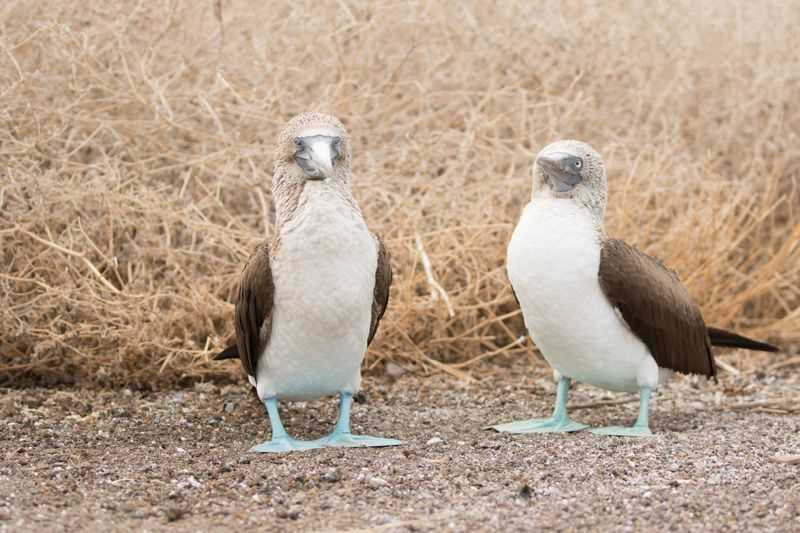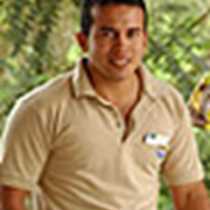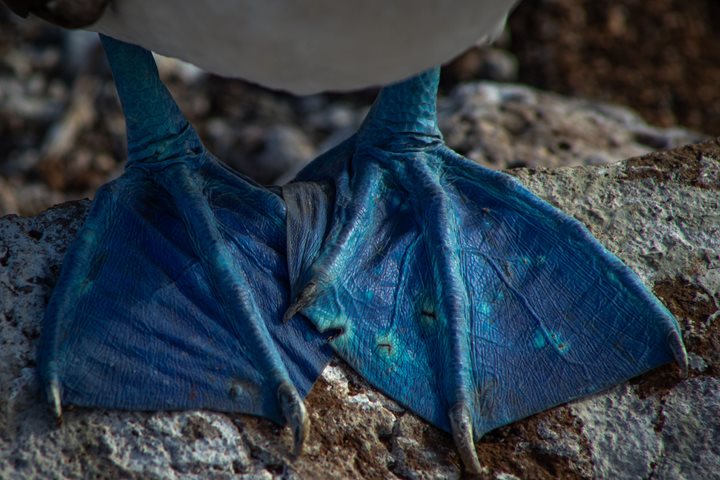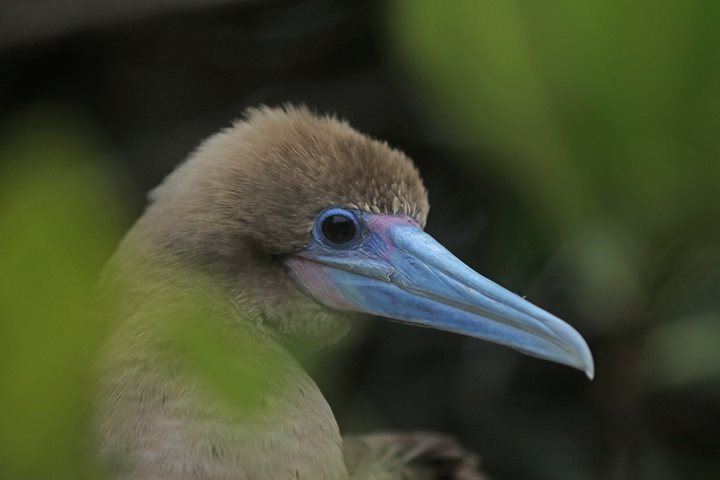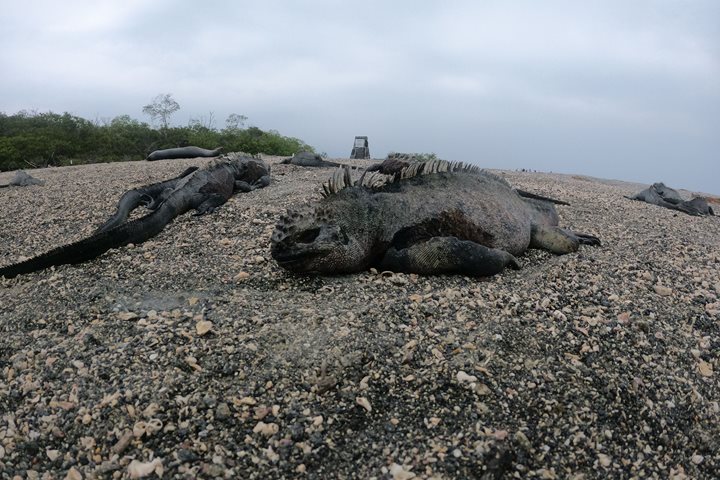Our pre-breakfast outing led us to a brackish water lagoon at Cormorant Point in Floreana Island. We were lucky to encounter several American flamingos feeding here as well as some common stilts and white-cheeked pintail ducks. As we continued our trek, we came upon sea turtle tracks. The white sandy beach we were currently on was a nesting ground of Pacific green sea turtles. After breakfast, we suited up for deep-water snorkeling around Champion Islet and spotted large colorful fish, several invertebrates on the rocky reefs, and even had sea lion pups swimming with us. Some of us had the opportunity to observe Pacific green sea turtles, and large schools of king angelfish. It was an incredible outing and an amazing opportunity to enjoy the blue heart of the planet.
After lunch we traveled to Post Office Bay, a historical site housing the oldest mailing system in the Americas. The wooden barrel found here serves as part of this mailing system, long ago established for communications between whalers and their loved ones in the eighteenth century. Floreana was well visited by sailors, since it has natural occurring fresh water and used to have plenty of Giant tortoises for sailors to take. The island is a mixture of nature, history, and adventure. To think that we were standing at a place where many daring sailors have been is quite exciting.- Daily Expedition Reports
- 27 Aug 2019
Cormorant Point and Post Office Bay, 8/27/2019, National Geographic Islander
- Aboard the National Geographic Islander
- Galápagos
Jonathan Aguas, Naturalist/Certified Photo Instructor
Jonathan was born into one of only a handful of families that reaches back five generations in Galápagos, in the town of Puerto Baquerizo Moreno, on San Cristobal Island. He first left the islands when he won a highly-coveted scholarship to finish hi...
Read MoreShare Report
Related Reports
7/2/2022
Read
National Geographic Islander
Genovesa Island
Today we spent the last day of our expedition at the island of Genovesa. It took us several hours of navigation to reach the island, which is located in the northern hemisphere and is home for more than a million birds! In the morning, we went out to explore Darwin Bay. We had an easy landing on a white sand beach covered by pieces of white coral. No matter where we looked, we spotted birds everywhere. Indeed, Genovesa Island holds the largest colony of red-footed boobies on Earth. More than 200,000 red-footed boobies are found here. These birds are so beautiful. They have a gorgeous blue beak with a pink mask and a black outline beneath their beaks. Red-footed boobies nest on bushes and trees. Their call is very distinctive and loud, and males and females are alike. During our easy stroll at Darwin’s Bay, our guests were lucky as they witnessed a swallow-tailed gull emerge from its shell. It was a miracle and a wonder of nature. I was fortunate to go kayaking with our guests inside of the protected caldera of Genovesa Island, and we enjoyed our last opportunity for deep water snorkeling. The waters are warmer here, and there are many colorful fish to observe. In the afternoon, we went to Prince Phillip’s Steps. After climbing the uneven steps, we reached the plateau and went to look for the elusive short-eared owl. We were very lucky, as we spotted two owls right by the trail. This is the best time of year for the owls. The storm petrels are nesting, and there is plenty of food for the owls. We went back onboard with feelings of amazement and gratitude. Galapagos is like the Garden of Eden. Humans encounter nature, and animals are not afraid of us. Those are the gifts that we keep for the rest of our lives!
2/1/2022
Read
National Geographic Islander
Isabela and Fernandina Islands
We woke up early in the morning as National Geographic Islander navigated along the northern part of Isabela Island. Slowly the sun appeared above the clouds surrounding Volcano Wolf. We spotted our first birds as Galapagos fur seals returned to shore from their night hunt. We enjoyed a great breakfast. Afterward, expedition leader Vanessa called everyone to the bow to celebrate as we crossed the equator. Our guests happily crossed the line. Approaching Punta Vicente Roca, the visitor site, we spotted Galapagos sea lions and a good number of ocean sunfish. The first activity of the day took place as we dropped anchor at Punta Vicente Roca. This is a spectacular geological site. The combination of the former volcano’s tall cliffs and the tuff cones formed later adds an amazing contrast to this unique visitor site. Our best tools for exploration, our Zodiacs, were lowered down, and off we went to explore the coast. We observed Nazca boobies and blue-footed boobies resting on the small ledges of the tuff cones. Galapagos sea lions swam close to our Zodiac, and Galapagos penguins rested on a broken piece of the tuff cone after feeding. What a wonderful sight! In a calm area, we found a good number of Pacific green sea turtles. The morning’s activities ended with snorkeling. Pacific green sea turtles, plenty of colorful fish, Galapagos marine iguanas and flightless cormorants surrounded us. It was a phenomenal experience! The ship was repositioned toward Fernandina Island. The youngest island of the archipelago, Fernandina is a highlight of our expedition. This island shows our guests the beginning of life. We observed animals thriving in the hostile environment. Pioneer plants like lava cacti grow on the lava fields, breaking down rocks little by little to create soil for the next generation of plants. Punta Espinoza is known for its huge colony of Galapagos marine iguanas. It is hard to distinguish the iguanas from rocks since they are so dark in color. On the other hand, colorful Sally Lightfoot crabs added contrast to the young, dark lava fields. We ended our walk as the sun was setting, returning to the ship with great memories. It was a fantastic day in the western part of the archipelago.

